R.E. Kearney's Blog, page 39
March 24, 2016
Viral Diseases
Emerging viral diseases are always high value news items. However, how will viruses change over the next few years? In recent years, the most significant virus of them all, in terms of human cases and death toll, was the re-emergence of Ebola, which is causing the biggest outbreak of the disease in history. But there is also chikungunya fever, which appeared in the United States for the first time in July, and enterovirus D68, a previously rare disease causing an outbreak of respiratory illness among U.S. children.
Humans have come a long way in preventing viral diseases over the last one hundred years. Children receive vaccinations against nine viral diseases, including many that used to cause life-threatening complications, such as polio. But still, there are fewer treatments for viral diseases than for those caused by bacteria, and when infectious disease pandemics emerge, the pathogens that are the most lethal are the viruses.
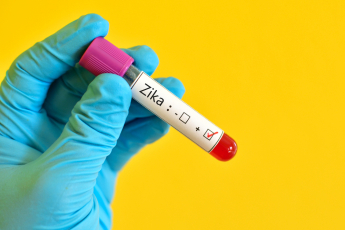 Treatments for viral diseases have generally stayed far behind treatments for bacterial diseases. One reason for that is simply because scientists have been working on antibacterial treatments for longer. Viruses are also much smaller than bacteria, and they have fewer genes or proteins to target with treatments. Viruses also mutate much more quickly than bacteria, so any therapy that is developed may no longer work after a short time.
Treatments for viral diseases have generally stayed far behind treatments for bacterial diseases. One reason for that is simply because scientists have been working on antibacterial treatments for longer. Viruses are also much smaller than bacteria, and they have fewer genes or proteins to target with treatments. Viruses also mutate much more quickly than bacteria, so any therapy that is developed may no longer work after a short time.
In addition, bacteria are living cells that divide on their own, and a lot of drug treatments against bacteria work by knocking out essential functions of those cells, such as the ability to replicate. But viruses are not made of cells, and they are even not exactly “alive” — they just hijack the machinery of their hosts’ cells in order to replicate, so researchers can’t target virus functions or replication in a traditional way.
When the first antibiotics were developed in the 1940s, they were considered something akin to a miracle cure for diseases that had once seemed unstoppable. A few decades later, scientists developed drugs against viruses, known as antivirals. However, although there are “broad-spectrum” antibiotics, which are single drugs that work against dozens of bacteria, the spectrum for antivirals is much narrower. Most antiviral drugs are specific for one type of virus, although some work against two or three.
Some of the most successful antiviral drugs inhibit a certain viral enzyme called reverse transcriptase, which synthesizes parts of the virus. Several drugs against HIV work in this way. However, only RNA viruses (HIV for example) use reverse transcriptase, so drugs against this enzyme will not work for DNA viruses. In addition, the structure of reverse transcriptase can be very different depending on the virus, which is why an antiviral that works against HIV might not work for Ebola.
Discovering antiviral drugs is easier today than it used to be, thanks to new technologies. That should continue to be a strong factor in favor of humanity when it comes to fighting diseases of the future. A few decades ago, researchers had to test potential drugs individually, and it could take three to six months to test three hundred potential drugs, Now, the process is automated with robots, so those same three hundred drugs would require only a few days to test.
In addition, researchers can now view three-dimensional models of viral components on a computer, and quickly design and “test” compounds with computer programs that simulate the binding of drugs to viral components. However, because new antiviral drug treatments may be years or decades away, public health organizations are focused on stopping pandemics before they start. New viral diseases typically emerge because of human activity that brings people into contact with wildlife, such as road building, hunting and agriculture expansion. About 75 percent of emerging diseases in people come from animals. So to reduce the risk of an outbreak, researchers need to figure out ways to reduce the activity that brings us into contact with wildlife, particularly in incredibly hot areas where diseases tend to emerge, such as tropical areas. Pandemics of the future will hang on the thread of researchers being able to fight the onset of the disease with all the technology that is available to them.


March 18, 2016
Win a signed book
Starting today I’m giving away five signed books of my latest novel, Future Furies. Just enter the Goodreads Giveaway. It’s free to enter and continues until April 2nd. Good luck!


March 16, 2016
Brief Introduction to Nanotechnology
In modern times, the use and control of tiny matter (nanotechnology) has become increasingly important. It has many uses from developing sports equipment to medical applications, to uses within the textile industry and even helping with energy. There are, however, some concerns about its use. The tiny matter is referred to as nanoparticles. These particles are measured in nanometers (nm). A nanometer is one billionth of a meter (0.000,000,001m). Nanotechnology is concerned with the use and control of structures that are 1-100 nanometers in size.
Some of these nanoparticles occur naturally, for example in volcanic ash. Some occur by accident, for example during the combustion of fuels. Many occur by design. However, nanotechnology has a number of interesting potential applications in areas.
 Medicine
MedicineThings behave differently at the nanoscale. An excellent example is the fact that gold actually reflects red light at the nanoscale. This has resulted in the design of experimental systems that kill cancerous cells with normal visible light, but leave normal cells unharmed. Also, body tissue can be reproduced or repaired using nanotechnology, which could eventually develop into treatments to replace or repair organs.
Energy
Nanotechnology could be harnessed to consume extremely low amounts of energy, making it a vital alternative to current methods of supplying power.
Textiles
Nanotech is already at use in consumer products ranging from stain-resistant and anti-wrinkle textiles in clothing, to cosmetics. If keeping clothes clean isn’t enough, ‘smart clothing’ could monitor your heart rate and other vital signs.
Filtration
The relationship between the volume and surface area of some particles can change at nanoscales in such a manner that they can end up with more ‘outside’ than ‘inside.’ (If you’re a “Dr. Who” fan, think of it as the opposite of a TARDIS.) The advantage is that the more surface you have, the more reactions you can have on that surface. This can allow new kinds of filtering, such as water for drinking or light for solar energy.


March 10, 2016
Global Warming
From the North Pole to the South Pole, there is change in the air. The planet is warming up. Science fiction authors tell sometimes of what will happen with a warmer world—but that future isn’t so far away. Many changes are happening right now. This rising heat is melting sea ice and destroying glaciers. It’s changing the way animals live and the way our weather works. Slowly but surely, a warmer world will make its effects known. But what will that world be like?
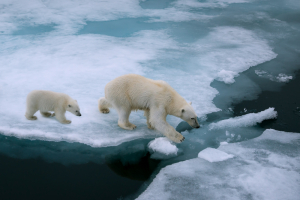 In the near future, sea levels are expected to rise over 7 inches, and by the end of this century, with continuous melting at the poles, those levels could add between six to eight inches more to seas around the world. Freak weather will become far more common with storms, hurricanes and other catastrophes looking ever more likely. Plants will bloom earlier than the insects that pollinate them. Droughts will become far more common. Fresh water will become rarer, and disease will run rampant with the onset of mosquitoes carrying malaria.
In the near future, sea levels are expected to rise over 7 inches, and by the end of this century, with continuous melting at the poles, those levels could add between six to eight inches more to seas around the world. Freak weather will become far more common with storms, hurricanes and other catastrophes looking ever more likely. Plants will bloom earlier than the insects that pollinate them. Droughts will become far more common. Fresh water will become rarer, and disease will run rampant with the onset of mosquitoes carrying malaria.
The ecoystems of the world are going to change drastically with animals on the move. Those that can adapt, will—those that cannot adapt will die. Polar bears have already been showing signs of becoming skinnier, and it has already been said that if the sea ice disappears, the polar bear will become extinct.
These are just some of the changes we will face in the future. But we already facing changes on a day-to-day basis. Researchers have tracked the decline of the Adélie penguins on Antarctica, where their numbers have fallen from 32,000 breeding pairs to 11,000 in 30 years. Some butterflies, foxes, and alpine plants have moved farther north or to higher, cooler areas. Spruce bark beetles have boomed in Alaska thanks to 20 years of warm summers. The insects have chewed up 4 million acres of spruce trees.
So it isn’t just science fiction authors who have ideas about a warmer future. It’s today, tomorrow and every day until the end of Earth’s life.


March 3, 2016
6 Predictions Nostradamus Made
Here are six predictions that the French Apothecary Nostradamus wrote in his collection of prophecies together with the passage from those prophecies. Was Nostradamus truly a foreteller of the future, or have his writings been misinterpreted and deciphered in such a way as to make the facts fit the writing?
Death of Henry II
“The young lion will overcome the older one,
On the field of combat in a single battle;
He will pierce his eyes through a golden cage,
Two wounds made one, then he dies a cruel death.”
In the summer of 1559, King Henry II of France (older one) lined up to joust the Comte de Montgomery (young lion), six years his junior, on the fields of France (field of combat). Both had lions on their shields.
In their final pass, Montgomery’s lance tilted up and burst through the king’s visor, splintering to pieces. Two shards, one through the eye (pierce his eyes through a golden cage), and one through the temple, lodged in the king’s head (Two wounds made one). Henry suffered for 10 days (then he dies a cruel death) before dying in his bed.
The Great Fire of London
“The blood of the just will be demanded of London
Burnt by fire in the year ’66
The ancient Lady will fall from her high place
And many of the same sect will be killed.”
The small fire that started in the bakery of Thomas Farriner on Pudding Lane in London, September 2, 1666 (in the year ’66) turned into a three-day blaze that consumed the city. One of the explanations for the “blood of the just” refers to the millions of flea-carrying rats that were killed. Peasant deaths were not recorded at the time, but it has long been held that six people perished in the fire.
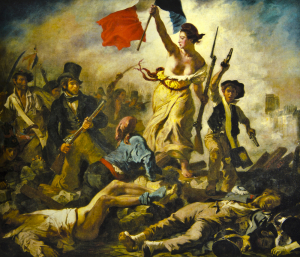 French Revolution
French Revolution“From the enslaved populace, songs,
Chants and demands
While princes and lords are held captive in prisons.
These will in the future by headless idiots
Be received as divine prayers.”
In 1789, the French people decided they’d had enough of poor aristocratic rule and revolted. The peasants (enslaved populace) took control of Paris and forced their demands on royalty. The aristocracy (princes and lords) were taken from power, locked in the Bastille (prisons) and beheaded at the guillotine (headless idiots).
Napoleon
“PAU, NAY, LORON will be more of fire than of the blood,
To swim in praise, the great one to flee to the confluence.
He will refuse entry to the Piuses,
The depraved ones and the Durance will keep them imprisoned. “
“PAU, NAY, LORON”: Three towns in southern France: Pau, Nay and Oloron.
The capitalization hints that something is hidden within the words and to look further.
Rearranging them spells out NAPAULON ROY, or Napoleon the King in French.
“More of fire than of the blood” refers to Napoleon’s non-noble lineage and “refuse entry to the Piuses” speaks to Popes Pius VI and VII, both imprisoned by Napoleon.
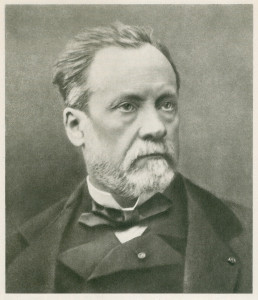 Louis Pasteur
Louis Pasteur“The lost thing is discovered, hidden for many centuries.
Pasteur will be celebrated almost as a God-like figure.
This is when the moon completes her great cycle,
But by other rumors he shall be dishonored.”
Louis Pasteur is credited (Pasteur will be celebrated) with discovering microbial decay (lost thing is discovered, hidden for many centuries). In 1995, the science historian Gerald L. Geison ran a story in the New York Times illustrating that Pasteur gave a misleading account on his preparation of the anthrax vaccine (shall he be dishonored).
Hitler
“From the depths of the West of Europe,
A young child will be born of poor people,
He who by his tongue will seduce a great troop;
His fame will increase towards the realm of the East.”
On April 20, 1889, Hitler was born in Western Europe, to very poor parents. Hitler moved Germany to action in the years following WW I, in part, through his over-the-top oratory skills (who by his tongue). “His fame will increase towards the realm of the East” refers to the Axis alliance with Japan in the East.


February 19, 2016
Nostradamus’s Predictions For The Future
 Nostradamus, was a French Apothecary who wrote a collection of prophecies that predicted the Great Fire of London, the rise of Adolph Hitler, as well as the attacks of 9/11.
Nostradamus, was a French Apothecary who wrote a collection of prophecies that predicted the Great Fire of London, the rise of Adolph Hitler, as well as the attacks of 9/11.
Here are six of his predictions for the future that may yet still come true.
The Disappearance of Language
The disappearance of the differences between languages may occur. Nostradamus predicted that this great development may soon lead to the end of actual nations, with a “new engine” in the world.
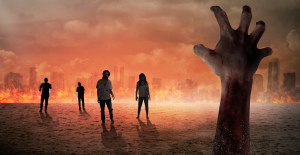 The Living Dead
The Living DeadThe resurrection of the dead is also foretold. According to Nostradamus, “the buried dead shall come out of their graves.” Such a chilling prediction will terrify the living—as Hollywood has made us all terrified of the dead.
Chain Reaction
Mount Vesuvius will have a major eruption. This massive event may happen in early 2016, according to some students of Nostradamus. Meanwhile, earthquakes may occur every ten minutes or so, before the deadly lava and ash flow starts.
Old Man
Humans will, apparently, live over 200 years. With the remarkable advances in medicine that have taken place over the last one hundred years—this doesn’t seem unlikely. Not only will we live longer, but we will look younger!
Talk to the Animals
Humans will learn to communicate with all animals. The big advances in the science of telepathy and animal communication skills will enable humans to talk to the pets and farm animals, as well. Nostradamus wrote that “the hog will become brother to man.”
Goodbye, Cruel World
The entire Western world will abolish all kinds of taxes. When a large revolt takes place, taxation will be ended. This has yet to happen.


Brief Guide To NATO
The North Atlantic Treaty Organization (NATO or the North Atlantic Alliance) is an intergovernmental military alliance based on the North Atlantic Treaty, which was signed on 4 April, 1949.
NATO was little more than a political association until the Korean War galvanized the organization’s member states, and an integrated military structure was built up under the direction of two U.S. supreme commanders. The course of the Cold War led to a rivalry with nations of the Warsaw Pact, which formed in 1955. Doubts over the strength of the relationship between the European states and the United States ebbed and flowed, along with doubts over the credibility of the NATO defense against a prospective Soviet invasion—doubts that led to the development of the independent French nuclear deterrent and the withdrawal of France from NATO’s military structure in 1966 for 30 years. After the fall of the Berlin Wall in 1989, the organization was drawn into the breakup of Yugoslavia, and conducted its first military interventions in Bosnia from 1992 to 1995, and later Yugoslavia in 1999. Politically, the organization sought better relations with former Warsaw Pact countries, several of which joined the alliance in 1999 and 2004.
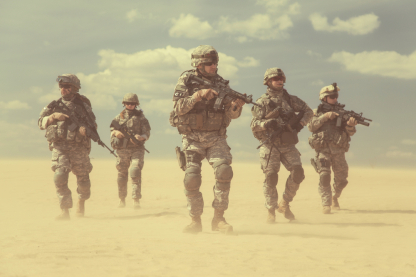 NATO constitutes a system of collective defense whereby its member states agree to mutual defense in response to an attack by any external party. NATO’s headquarters are located in Haren, Brussels, Belgium, where the Supreme Allied Commander also resides. Belgium is one of the 28 member states across North America and Europe, the newest of which, Albania and Croatia, only joined in April 2009. An additional 22 countries participate in NATO’s Partnership for Peace program, with 15 other countries involved in institutionalized dialogue programs. The combined military spending of all NATO members constitutes over 70 percent of the global total. Members’ defense spending is supposed to amount to 2 percent of GDP.
NATO constitutes a system of collective defense whereby its member states agree to mutual defense in response to an attack by any external party. NATO’s headquarters are located in Haren, Brussels, Belgium, where the Supreme Allied Commander also resides. Belgium is one of the 28 member states across North America and Europe, the newest of which, Albania and Croatia, only joined in April 2009. An additional 22 countries participate in NATO’s Partnership for Peace program, with 15 other countries involved in institutionalized dialogue programs. The combined military spending of all NATO members constitutes over 70 percent of the global total. Members’ defense spending is supposed to amount to 2 percent of GDP.
Article 5 of the North Atlantic treaty, requiring member states to come to the aid of any member state subject to an armed attack, was invoked for the first and only time after the 11 September, 2001 attacks, after which troops were deployed to Afghanistan under the NATO-led ISAF. The organization has operated a range of additional roles since then, including sending trainers to Iraq, assisting in counter-piracy operations, and in 2011, enforcing a no-fly zone over Libya in accordance with U.N. Security Council Resolution 1973. The less potent Article 4, which merely invokes consultation among NATO members, has been invoked five times: by Turkey in 2003 over the Iraq War; twice in 2012 by Turkey over the Syrian Civil War, after the downing of an unarmed Turkish F-4 reconnaissance jet, and after a mortar was fired at Turkey from Syria; in 2014 by Poland, following the Russian intervention in Crimea; and again by Turkey in 2015 after threats by the Islamic State to its territorial integrity.
The member states are: Albania, Belgium, Bulgaria, Canada, Croatia, Czech Republic, Denmark, Estonia, France, Germany, Great Britain, Greece, Hungary, Iceland, Italy, Latvia, Lithuania, Luxembourg, Netherlands, Norway, Poland, Portugal, Romania, Slovakia, Spain, Turkey, United States


5 Books That Foretold The Future
 “The World Set Free” by H.G. Wells
“The World Set Free” by H.G. Wells“The World Set Free” is one of those books that, sadly, may have changed the course of history with its technological predictions. Physicist Leó Szilárd read the book the very same year that the neutron was discovered.
Luckily, we’ve yet to create bombs quite like the ones he describes, which, when set off, cause a literal “blazing continual explosion.”
What Happened to the Corbetts? by Nevil Shute (1937)
Shute managed to predict air raids on major British cities years before the Second World War.
One of the most popular authors of his time, Shute set out to write a book that would educate about the danger of air raids by an enemy state. His story successfully foretold of a European superpower who bombs Southampton to devastating effect. The novel addresses the issues of the aftermath of bombing, such as the spread of disease from lack of clean water, and what may be done to relieve the distress of those affected by it. On the initial day of publication, several thousand copies of the novel were distributed free of charge to ARP members to inform them of what they might expect if war ever broke out in the skies… Just a few years later, the world was at war with Germany.
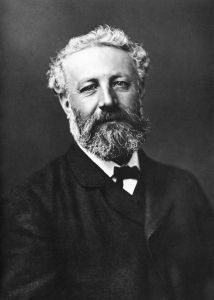 “Twenty Thousand Leagues Under the Sea” by Jules Verne
“Twenty Thousand Leagues Under the Sea” by Jules VerneJules Verne is known as one of the most talented authors of the 19th century, predicting everything from lunar modules to solar sails many, many years before they were invented.
His most famous book, however, is “Twenty Thousand Leagues Under the Sea.” Published in 1870, the novel predicted electric submarines years before they were officially invented.
“Looking Backward” by Edward Bellamy
Almost 70 years before credit cards were invented, Bellamy had a similar idea in his 1888 Utopian science fiction novel.
After Julian West falls asleep for 113 years and wakes up in the year 2000, he finds that everyone uses “credit” cards to buy goods. Though the way Bellamy’s cards work is closer to a debit card or Social Security dividend, it remains nonetheless an interesting prediction.
“Stranger in a Strange Land” by Robert Heinlein
This 1961 novel follows Valentine Michael Smith after he finally comes home to Earth after being raised by Martians since he was a child.
In addition to discussing futuristic topics such as intergalactic politics, “Stranger in a Strange Land” also predicted waterbeds a decade before they came to fruition.


Military Technology That Changed The World
The crossbow was invented in China but developed into a significant weapon in medieval Europe. With a mechanism for holding the drawn bow until it was ready to release, it propelled arrows with tremendous force over 350 yards. The crossbow allowed soldiers to fire from great distances and avoid close contact with the enemy. Swords, which had to be used at close range, were no match.
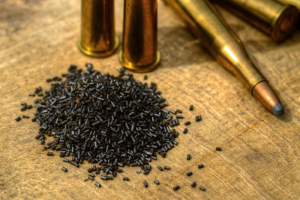 Gunpowder
GunpowderThe discovery of gunpowder led to the development of cannons in the 1300s. Cannons could demolish castle walls and blast through wooden ships. The cannon started as a clumsy battlefield weapon but soon became one of the most essential chess pieces for military commanders. As the weapon became more advanced, more uses were found for it.
Machine Guns
Machine guns allowed for rapid, continuous fire, thereby eliminating frequent reloading. The first was the Gatling gun, used in the American Civil War. The British soon carried them over to the Boer War, and soon the machine gun became one of the most common sights on the battlefield.
The Tank
The tank, an armored combat vehicle equipped with a cannon and machine guns, replaced the use of rifles in war. It put an end to trench warfare, since tanks, with their caterpillar traction, could easily bulldoze over trenches. Tanks were first used at the end of World War I, and they emerged as a symbol of modern warfare. They are still highly used today.
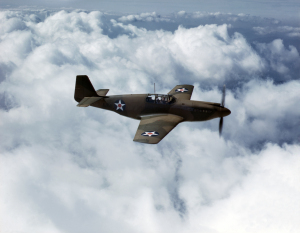 Aircraft
AircraftCombat aircraft, both bombers and fighter planes, changed the nature of war during World War II. Air superiority became critical to victory. The British Spitfire, American Mustang, and German Messerschmitt were among the most famous fighter planes of the war. Planes had first been used to great effect in the First World War, but the intervening years took them from being tools for scouting to tools of devastating power.
Nuclear Bombs
Nuclear weapons, first developed in 1945, allow for massive destruction. Atom and hydrogen bombs are examples of nuclear weapons. Because these weapons are so perilous to human existence, treaties limit their development, but many rogue countries still hope to build them.
Precision Smart Bombs
Smart bombs are highly accurate bombs that are guided to their targets by computers. Smart bombs hit their targets much more frequently than unguided dumb bombs and cause both fewer casualties and less damage to civilian areas.






